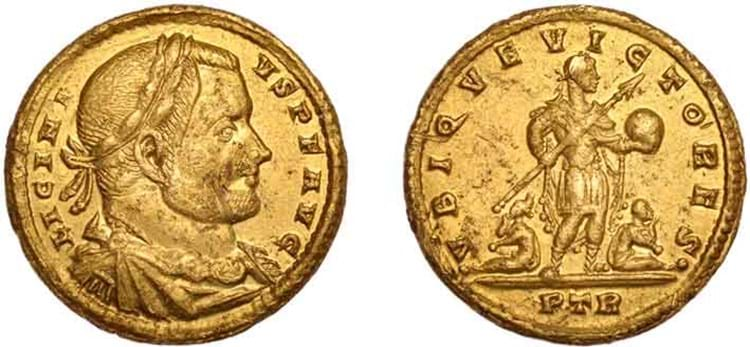
The coin, one of only four known examples of a gold one-and-a-half solidus from the reign of Emperor Licinius I, is to be sold by coins and medals specialists Dix Noonan Webb on Thursday, December 5.
"This is an incredibly exciting discovery which was made in the most unpromising circumstances," said Christopher Webb, head of the coins department at Dix Noonan Webb. "The three other known examples of this type are all in some of Britain's most famous museum collections".
The metal detecting enthusiast who discovered it at first thought that it was the gold foil from a packet of Rolos, the Rowntrees' chocolates.
"I had not had a single signal for about 15 minutes when I got a slight response, one that any detectorist will tell you is not worth digging," he recalled. "However having had so very few signals for a while, I decided to dig it up. Six inches down I dug out a clod of earth and sticking out of the side was the unmistakeable glint of gold.
"Having dug lots of sweet wrappers up over the years, I thought it was the foil from a packet of Rolos, but on pulling it out of the mud I saw it was a coin."
Rare Discovery
Further research revealed its rarity. Licinius I was Emperor of the western half of the Roman Empire from 308-313AD and the eastern half from AD313-324. In 324 he was deposed after losing a civil war with his brother-in-law Constantine I, who ruled the western part of the empire, and the following year was hanged.
After his death, all statues of Licinius were pulled down, his laws abolished and many of his coins melted down.
The coin found in South Wiltshire - and reported via the Portable Antiquities Scheme - was made at Trier in Germany, then the site of the main mint of the western Roman Empire, around 313AD. It is just 21mm (0.8in) in diameter and weighs 5.32 grams (0.2oz).
Coins like this were struck for the emperor to distribute at special occasions and so it began life as a gift. The only other known examples are in the British Museum in London, the Hunterian Museum in Glasgow and the Ashmolean Museum in Oxford.




